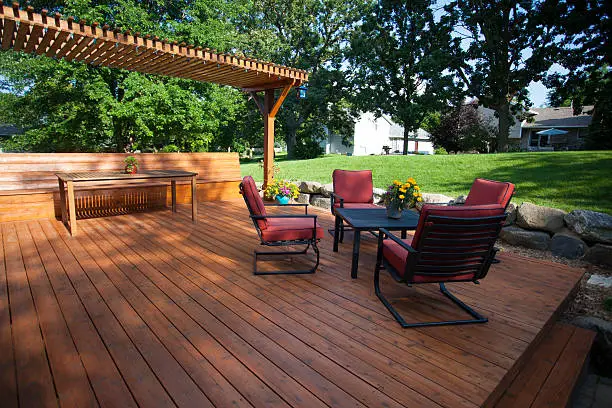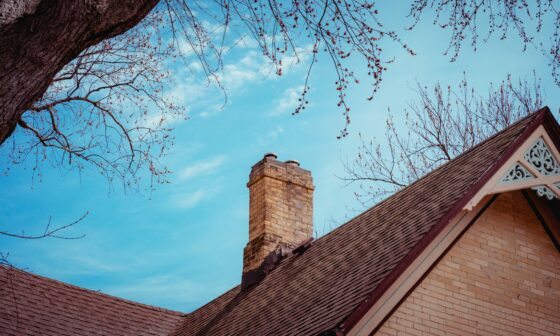
Ever dreamt of building your own deck but felt daunted by the task? Well, you’re not alone. Deck building can seem like a colossal venture, especially if you’re new to it. But here’s the good news: with the right tips and tricks, you can turn that dream deck into a reality.
Deck building is not just about nailing boards together. It’s about creating an outdoor space that’s functional, durable, and aesthetically pleasing. And while it might involve some hard work, the satisfaction of crafting something with your own hands is unmatched.
So whether you’re a seasoned builder or a DIY novice, this article is here to guide you. We’ll share precious insights on everything from protecting your deck’s structure from moisture to choosing the right materials. So let’s dive in, shall we?
Exploring Different Deck Materials
Building a deck? You’ve likely found that the choice of materials is as wide as your imagination. It’s therefore essential to understand your options to make an informed decision. Let’s look at some of the most popular materials you might consider for your deck.
Wood Decks
Nothing quite matches the natural beauty of a real wood deck. Not only does it offer a timeless aesthetic, but it also creates a warm, inviting space to enjoy your outdoor surroundings. One popular choice for wood decking is pressure-treated lumber, it’s resistant to rot and insect damage, and it’s also a cost-effective option.
Keep in mind that maintenance is key. Depending on the type of wood, you may need to restain or repaint your deck every two years or so.
If you’re willing to invest a little more upfront for lower maintenance, consider hardwoods like ipe or mahogany. They are dense, durable and resist warping, cracking and pests. Furthermore, you’ll love their rich colour and texture which can make your deck look really premium.
Composite Decks
Composite decking is a popular alternative to wood for homeowners who want something low-maintenance. This planking material is made from a mixture of plastic and wood fibres. Composite Decks are resistant to rot, warping, and splintering, so you won’t have to worry about annual sanding and staining.
They also come in a variety of colours and styles, some even mimic the look of real wood. While composite decks do have a higher upfront cost than other decking materials, their durability and low maintenance requirements can make them a cost-effective choice in the long run.
PVC Decks
If you live in a particularly wet climate, or plan on building a pool deck, PVC decking may be the best option for you. Made entirely out of Polyvinyl chloride (PVC), this decking material doesn’t contain any wood fibres. This means it’s more resistant to water damage and rot compared to other decking materials.
PVC is also highly customizable, as it is available in a variety of colours. Maintenance for PVC decks is minimal, with no need for staining or sealing. However, like composite decking, the upfront cost for PVC can be higher than other materials.
By knowing the different deck materials and their attributes, you’ll better equipped to build a deck that strikes the perfect balance between style, durability, and maintenance.
Every material has its pros and cons, so take your time to make a choice that aligns with your needs and preferences. Remember, building a deck is a long-term investment, so it’s important to select a material that’ll serve you well for years to come.
Planning and Designing Your Deck
Planning and designing your deck is just as important as the building process itself. It involves considerate decision-making, careful measuring, and choosing the best layout. All these factors determine how well your deck fits the available outdoor space and meets your specific needs.
Setting a Budget
First thing’s first, establishing a budget. This involves a lot more than just deciding on an overall sum you’re willing to invest in your deck project. You need to take into account the cost of materials, whether it’s high-end hardwood or budget-friendly composite decking.
Remember, your budget should also factor in the installation costs, which might include the labour fee if you’re hiring professionals. It’s also wise to take into consideration potential maintenance costs down the line.
Measuring Your Outdoor Space
Next, you’ll need to measure your outdoor space. This goes beyond simply checking how much square footage you have available. You’ll need to consider more than just the width and length of your space. Take into account any features of your home or yard that could influence the size or shape of your deck. Things like exterior doors, windows, trees, or slopes can all impact your design.
Choosing a Deck Layout
Lastly, choosing a deck layout is about more than just aesthetics. If your deck will change elevations, for instance, it could make sense to finish one section before starting the next. The ledger board (a beam fixed to the house) is often the best starting point as it offers a stationary surface to pull measurements from and attach joists to. Remember, stairs and landings should be the final step in framing your deck.
Moreover, you’ll want to think about your deck in terms of its functionality too. What do you intend to use it for? An open plan deck might be most suited if you’re going to use it for entertaining, whereas a multi-level deck may work better for a children’s play area or for creating different sun and shade areas.
Take your time during this phase. An effectively planned and well-designed deck not only adds value to your home, but it can also become a favourite outdoor spot for you and your family to relax and enjoy.
Deck Construction Process
While you’ve already grasped the importance of planning and designing for your deck, it’s time to roll up your sleeves and get into the actual construction process. It’s the nuts and bolts, or rather – the footings and the deck boards. Let’s dive right into it, shall we?
Preparing the Site
You’ve chosen the ideal location for your deck. Now, it’s time to get that site ready. To ensure a secure and level base, you should dig holes for footings that are wide enough to hold the footing form and deep enough to extend below the frost line. This precision digging ensures your deck stays true through the seasons – frost, rain or shine.
But here’s the thing. Once the footing forms are assembled and set inside each hole, don’t rush to fill them with concrete. Instead, gently backfill – allowing your constructions to seamlessly blend with their immediate surrounds for an enhanced structural integrity.
Building the Substructure
When it comes to deck building, the substructure is your unsung hero. It’s the firm foundation taking all the weight, ensuring your deck stays up sturdy. Undeniably, options abound – from deck blocks sitting directly on the ground to the more elaborate screw piles.
Screw piles truly shine with their versatility. Whether you’re dealing with rocky terrain or need accurate positioning of the substructure, they’ve got you covered. But remember, they demand precision during installation. You’ve little wiggle room once they’re screwed in. Too daunting? Consider recruiting the services of a dedicated screwpile contractor.
Aiming for excellence in durability? Pursue a galvanized substructure – it’s a contender worth the spotlight. It’s the underdog that packs a punch in resisting decay, a perfect choice to prevent your deck’s underparts from rotting when the decking itself is still quite functional.
Personalise your substructure the smart way. Avoid rusting issues often observed with coated deck screws after a decade or so. Yeah, that’s right—stainless steel screws extend your deck’s lifespan, offering unmatched strength and aesthetic charm.
Installing Decking Boards
Congratulations! It’s time to top off the cake – literally. Adding the decking boards is like adding icing to a cake. It completes your deck and, most importantly, provides the surface you’ll be walking on.
Feeling a little adventurous? Consider recycled plastic composite decking boards. They might be a tad more expensive than conventional wood. But here’s their secret – they’re super durable and even have profiled, anti-slip surfaces. A crucial feature – especially if your deck is prone to slime or is under tree coverage.
At this stage, you’ve got all tools in your toolbox to construct an amazing deck. So go ahead, let your craftsmanship take the front seat and watch your dream deck manifest right before your eyes.
Adding Finishing Touches
Once your basic deck structure is in place, it’s time to start thinking about how to make it truly your own. This means looking at staining or sealing, installing railings, and considering lighting and decor.
Staining or Sealing the Deck
The first thing you’ll want to consider is whether to stain or seal your deck. With this simple step, you’re not just adding a splash of colour – you’re also giving your deck an extra layer of protection from the elements. Staining your deck can add aesthetic appeal, but remember, it requires regular upkeep to prevent fading.
Alternatively, if you’re a fan of your deck’s natural appearance, you might decide to use a sealer instead. Sealers are clear and have the advantage of locking out moisture, which helps to prevent rot and preserve the original look of your wood. It’s up to you whether you stain, seal, or do both.
Installing Railing and Balustrades
Next on the list is installing railings and balustrades. You might be wondering why this is important. Well, apart from the obvious safety aspect, railings and balustrades also add to the overall aesthetic of your deck. Whether you choose a simple, minimalist design or go all out with an ornate, custom-made option, your choice will give your deck that personal touch that says ‘this is my space’.
Adding Lighting and Decor
Finally, consider adding that extra zing to your deck with the addition of lighting and decor. If you enjoy basking in the evening air, outdoor lighting is a must-have. Install ambient garden lights, hang up a few lanterns, or add some twinkling fairy lights for a magical effect.
As for decor, think of your deck as an extension of your home. Add some outdoor furniture, a few hardy pot plants, and perhaps a high-quality outdoor rug to bring a cosy indoors feel to your deck.
And there you have it. It’s these finishing touches that can take your deck from good to amazing. It’s all about personalising your space. Make it a place where you’ll love spending time, whether that’s hanging out with friends, enjoying family meals, or just relaxing alone with a good book.
The options are endless and the choices are all yours. Remember, this is your project, so get creative, have fun, and most importantly, be proud of your creation.
Maintaining Your Deck
Just as you show love towards your home interiors, your deck demands a little TLC too. With all the outdoor activities and seasonal changes, it’s anticipated that your deck needs maintenance. Here’s how you can keep your deck in top-notch condition.
Regular Cleaning and Inspections
To keep your deck sparkling and vibrant, it’s essential to undertake regular cleaning. Cleaning decks not only amplifies its appeal but also extends its lifespan. You may find debris and leaves trapped between deck boards.
It may seem harmless at first but over time, it can lead to mould development depreciating your deck. Regular cleaning keeps these issues at bay ensuring a healthy deck lifespan.
But how often do you inspect your deck? Regular inspections play a critical role in maintaining your deck. Keep an eye on any cracks or loose boards. Check for any signs of rot, specifically around steps and posts where rot tends to begin.
Inspect railings and balustrades to guarantee they’re firm and sturdy. A close inspection will help you detect any early signs of damage offering an opportunity for quick action.
Repairs and Replacements
No matter how consistent you are with regular deck cleaning and inspections, wear and tear are inevitable. Over time, some deck parts may demand repairs or replacements. For instance, a snapped board needs immediate replacement. Fixing loose nails is yet another common deck repair task.
Remember, overlooking minor problems often leads to major ones, possibly making a significant dent in your pocket. Undertaking necessary repairs proactively averts catastrophic failures, keeping your deck safe and beautiful for years to come.
Seasonal Maintenance Tips
Different seasons bring about diverse challenges for a deck. During winter, ensure to clear off any snow to avoid any potential damage. As spring steps in, it might be the perfect time to carry out a detailed deck inspection. Come summer and it’s time for deck sealing. An annual seal prevents water absorption, which could lead to deck warping or cracking.
Conclusion
Deck maintenance isn’t just about keeping your outdoor space looking great. It’s a sure-fire way to extend your deck’s lifespan and save you from unnecessary expenses down the line. Regular cleaning and inspections are your first line of defence against issues like mould and rot.
Don’t forget that small problems can escalate if they’re left unchecked, so it’s crucial to deal with them as soon as they crop up. Seasonal maintenance also plays a big part in keeping your deck in top shape. Whether it’s clearing snow in winter or sealing your deck in summer, these steps can make a world of difference. So, take these tips to heart and you’ll have a deck that’s not only safe and beautiful but stands the test of time.


